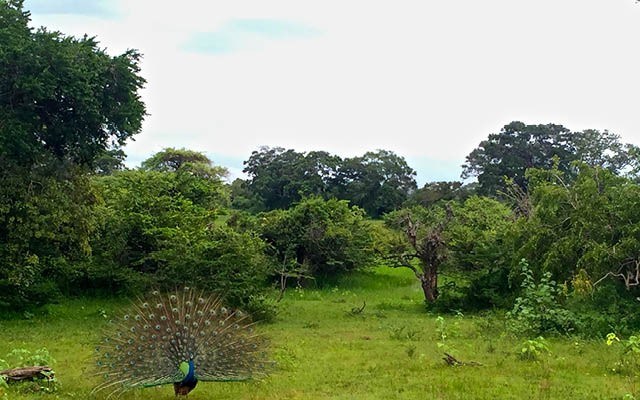When you're travelling, the desire to experience everything can sometimes lead to regrettable choices. One of these occurred for me in the southern reaches of Sri Lanka last winter, and despite its humourous overtones, at the root lies a sad indictment of what happens when ecotouristic ventures meet overzealous human enterprise.
Hoping to see a few elephants and maybe a leopard in Yala National Park, where hiking on your own wasn't allowed, we'd hesitantly signed up for a "special" safari we'd been assured was eco-friendly. Staying in the nearby town of Tissamaharama, we were up at 4 a.m. and in the Jeep by 4:30 with our teenage driver and a banana and scrambled-egg sandwich. The high-speed 25-kilometre drive to the park, however, was clearly a race of some kind that soon revealed itself as a bid to get to the required permit offices before dozens of other Jeeps doing the same. We sat for almost an hour outside the park gate as the sun rose behind us, while bleary-eyed, bewildered tourists arrived in Jeep after Jeep after Jeep — many carrying only one or two people instead of their capacity of six. All doubtless wondered what kind of motorized rodeo they'd paid $75 to $100 each for. Given the safari hard-sell all over town and the embarrassing glut of vehicles, we now suspected it would be a shit show, yet it proved so far beyond that as to be tragicomic.
As soon as the drivers/guides got their permits (allotted through a system of favouritism and bribes), the scramble was on to reach the park gate less than a kilometre away, a terrifying, Mad Max Road Warriors-style dash of Jeeps all attempting to squeeze in ahead of each other at the single-vehicle-wide entrance. As we jammed through, an uninvited Yala Park "tracker" hopped in beside us promising to find the "best" animals. Mostly he fingered the same pedestrian fauna — feral cattle, introduced water buffalos, spotted deer and invasive wild boars — that the driver kept urgently pointing to as if these were either novelties or we were blind. We did spot one distant lone elephant, a jackal, a couple types of monkeys, numerous land monitors, and two crocodiles. Only the bird fauna, however, proved interesting, with new species every few metres. There were Sri Lanka junglefowl (the national bird) and peafowl galore, the males commanding the apices of dead trees and the centre of meadows, where one unpacked its full shimmering dance for our benefit. Waterbirds abounded, including egrets and herons as well as black-headed ibis, painted stork, and spoonbill. Several raptors lurked on the bare perches unoccupied by peacocks. In the brush close to the road (all of it non-native invasive plants) swooped colourful bee-eaters, parakeets, iridescent kingfishers and one extraordinary Asian paradise-flycatcher with a wispy white tail that floated behind like a ribbon as it flew.
The ride, however, was brutal. Unanchored, we were repeatedly thrown up and down and sideways by the incredibly rutted and rain-ruined roads. Cameras were impossible. On his cellphone, our driver was constantly texting other drivers in his clique to share information on animals; several kilometres away, someone spotted a leopard in a tree and five Jeeps — ours included — roared off in that direction at once, frightening the animal into instant flight. And on it went. Instead of wild animals to observe there was naught but wild Jeeps. A breakfast break at a beach around 9 a.m. was beyond distasteful; at least 40 Jeeps clustered there, their passengers peeing and shitting in the bushes, leaving the spoils and wadded paper behind because there was neither toilet nor garbage receptacles. This explained the swarm of apple-sized dung beetles — perhaps the most compelling animal we saw all day.
As the only way to experience this so-called National Park, the unregulated safari scene seemed insane, troubled, wrongheaded and completely unsustainable. And this same shameful scene unfolded every single day, adding to the feeling we had after several weeks in Sri Lanka that whenever there was a way to make money from tourists, it was overexploited to the point of absurdity and the detriment of the attraction and whatever experience you hoped to derive from it. There was no adventure to be had or reverence to share in this kind of "safari," only sympathy and regret for the animals involved — including humans.
Out on the beach was a small fishing village near a prominent rock outcrop where many were killed during the December 2004 tsunami. Indeed, the spot where we parked had once been a park service building — undoubtedly housing the missing facilities — where several employees had also perished. And though there'd been no money to re-build or hire new employees, Yala Park was more or less obligated to allow safari contractors continued free reign because of their role in the local economy. It was the worst kind of a Catch-22 — no safaris meant no jobs, no money for conservation, and more exploitation of the park's animals; but safaris also undermined all conceivable conservation efforts, making us de facto complicit in the exploitation of animals and people.
Never again. There has to be a better model.
Leslie Anthony is a Whistler-based author, editor, biologist and bon vivant who has never met a mountain he didn't like.




